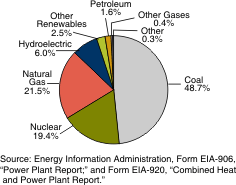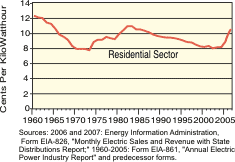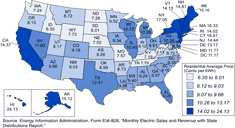


In 2007, Hawaii residential consumers paid the highest rate (24.13 cents per kilowatt hour) because the primary fuel used to generate their electricity is oil, which is expensive.
Idaho residential consumers paid the lowest rate (6.35 cents per kilowatt hour) because of the availability of economical hydroelectric power.
Many Technologies and Fuels are Used to Produce Electricity
About 90% of U.S. electricity is generated by three fuels: coal, nuclear, and natural gas.
Most electricity is generated by rotating turbines that drive alternators. Turbines are typically driven by water, wind, hot gases, and most commonly steam. Steam is produced in several ways:
From water that is boiled by burning either fossil fuels (coal, natural gas, or petroleum) or biomass materials (wood, wood waste, municipal solid waste, agricultural waste, and other waste materials) or by nuclear fission
From geothermal resources where hot water or steam under pressure in geothermal reservoirs in the earth’s crust emerges from the ground and drives a turbine
From a fluid heated by the sun (solar power)
Electricity Is Delivered to Consumers Through a Complex Network of Transmission and Distribution Lines
Power is generated at power plants and then moved to substations by transmission lines—large, high-voltage power lines, often supported by tall metal towers. In the United States, the network of nearly 160,000 miles of high voltage transmission lines is known as the "grid."
A local distribution system of smaller, lower-voltage distribution lines—often supported by wood poles—then moves power from substations and transformers to customers.
Many Factors Affect the Price You Pay for Electricity
Factors that affect the price of electricity include:
- Cost and availability of the resources used for power generation (e.g., water is relatively inexpensive while natural gas tends to be more costly)
- Construction and maintenance costs of power plants
- Cost of maintaining and using the transmission system to deliver electricity
- Supply and demand for input fuels and for transmission lines
- Weather conditions (e.g, storms, extreme heat)
- Regulations. For example, in some States prices are fully regulated by Public Service Commissions, while in others there is a combination of unregulated prices (for generators) and regulated prices (for transmission and distribution)
In most parts of the United States, supply and demand cause monthly and even daily price fluctuations. Demand is usually highest:
- In the afternoon and early evening (these are "on-peak" hours)
- During the summer months when air-conditioning use is greatest
Climate can also affect supply, particularly for renewables such as hydropower, wind, and solar.
However, residential consumers in many areas pay rates based on the monthly average price of electricity so they do not experience these price fluctuations.

